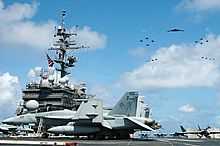Military exercise

A military exercise or war game is the employment of military resources in training for military operations, either exploring the effects of warfare or testing strategies without actual combat. Exercises in the 20th century have often been identified by a unique codename in the same manner as military operations.
Types

- Field exercise
- The more typically thought of exercise is the field exercise, or the full-scale rehearsal of military maneuvers as practice for warfare. Historical names for field exercises in the Commonwealth include 'schemes.' In a field exercise, the two sides in the simulated battle are typically called "red" and "blue", to avoid naming a particular adversary.
- Simulation
- Other types of exercise include the TEWT (Tactical Exercise Without Troops), also known as a sand table, map or cloth model exercise. This type of exercise (in recent years assisted by computer simulation) allows commanders to manipulate models through possible scenarios in military planning. This is also called warfare simulation, or in some instances a virtual battlefield and in the past has been described as "wargames." Such examples of modern military wargames include DARWARS, a serious game developed since 2003 by the US DARPA agency with BBN Technologies, a defense contractor which was involved in the development of packet switching, used for ARPANET, and which developed the first computer modem in 1963.
- Joint exercise
- Several different armed forces training together are called having a joint exercise. Said forces may be different branches of the armed forces from one country or may be armed forces from different countries.

History
_%26_HMS_Illustrious_(R_06).jpg)


The modern use of military exercises grew out of the military need to study warfare and to 'reenact' old battles for learning purposes. During the age of Kabinettskriege (Cabinet wars), Frederick the Great, King of Prussia from 1740 to 1786, "put together his armies as a well-oiled clockwork mechanism whose components were robot-like warriors. No individual initiative was allowed to Frederick's soldiers; their only role was to cooperate in the creation of walls of projectiles through synchronized firepower." [1]
This was in the pursuit of a more effective army, and such practices made it easier to look at war from a top-down perspective. Disciplined troops should respond predictably, allowing study to be confined to maneuvers and command.
The stunning Prussian victory over the Second French Empire in the Franco-Prussian War (1870–71) is sometimes partly credited to the training of Prussian officers with the game Kriegspiel, which was invented around 1811 and gained popularity with many officers in the Prussian army. These first wargames were played with dice which represented "friction", or the intrusion of less than ideal circumstances during a real war (including morale, meteorology, the fog of war, etc.).
21st century militaries still use wargames to simulate future wars and model their reaction. According to Manuel de Landa, after World War II the Command, Control and Communications (C3) was transferred from the military staff to the RAND Corporation, the first think tank.
Von Neumann was employed by the RAND Corporation, and his game theory was used in wargames to model nuclear dissuasion during the Cold War. Thus, the US nuclear strategy was defined using wargames, SAM representing the US and IVAN the Soviet Union.
Early game theory included only zero-sum games, which means that when one player won, the other automatically lost. The Prisoner's dilemma, which models the situation of two prisoners in which each one is given the choice to betray or not the other, gave three alternatives to the game:
- Neither prisoners betrays the other, and both are given short-term sentences
- One prisoner betrays the other, and is freed, while the other gets a long sentence
- Both prisoners betray each other, and both are given mid-sized sentences
While the first is their best overall choice, neither of them can be sure that the other wouldn't betray him (and thus be freed while he would get a long sentence). Thus, betrayal was considered as the most rational thing to do, i.e. minimaxing the losses (getting the possible loss to be the minimal possible).
This modelization gave the basis for the massive retaliation nuclear doctrine. The zero-sum fallacy and cooperative games would be theorized only later, while the evolution of nuclear technology and missiles made the massive retaliation nuclear strategy obsolete.[2]
Military wargaming was thus progressively improved, although according to Manuel de Landa it still suffers today from a systemic bias on conflict against cooperative behavior. Dice, which were a rational way to represent chaos, were replaced by the Prussians by artillery range tables, and then by evaluation of each weapon's lethality, etc.
See also
- Maneuver warfare
- Flanking maneuver
- Pincer movement
- Simulation
- Aggressor squadron (aircraft in military wargames)
- Live fire exercise
References
- ↑ Manuel de Landa, War in the Age of Intelligent Machines, p.127, Swerve Editions, New York, 1991
- ↑ Concerning the use of military wargames, see Manuel de Landa, War in the Age of Intelligent Machines
External links
- Complete 911 Timeline: Military exercises up to 9/11